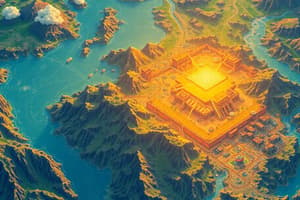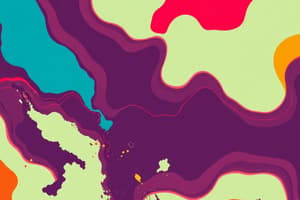Podcast
Questions and Answers
What is a common characteristic of all maps?
What is a common characteristic of all maps?
- They are all drawn to scale (correct)
- They are all hand-drawn
- They are all in 3D
- They are all used for navigation
Maps are always more detailed than globes.
Maps are always more detailed than globes.
False (B)
What is the main purpose of using conventional notations on a map?
What is the main purpose of using conventional notations on a map?
To provide background information
Maps show the earth's surface as if it were seen from directly above, which is called a ___________ view.
Maps show the earth's surface as if it were seen from directly above, which is called a ___________ view.
What is the primary difference between traditional map-making and modern map-making?
What is the primary difference between traditional map-making and modern map-making?
Match the following characteristics with the correct type of map representation:
Match the following characteristics with the correct type of map representation:
Globes are always more simplified than maps.
Globes are always more simplified than maps.
What is the name of the view that maps provide?
What is the name of the view that maps provide?
What was one of the greatest challenges in traditional map-making?
What was one of the greatest challenges in traditional map-making?
Modern maps are always pictographic.
Modern maps are always pictographic.
What is the significance of the 17th century in modern scientific mapping?
What is the significance of the 17th century in modern scientific mapping?
Satellite imagery provides a wealth of information about ________________.
Satellite imagery provides a wealth of information about ________________.
What is one of the major uses of maps in geography?
What is one of the major uses of maps in geography?
Computers are not used in modern map-making.
Computers are not used in modern map-making.
Match the following map-making techniques with their characteristics:
Match the following map-making techniques with their characteristics:
What is the significance of aerial photography in modern map-making?
What is the significance of aerial photography in modern map-making?
Flashcards are hidden until you start studying
Study Notes
What is a Map?
- A map is a simplified, diminished, plain representation of all or part of the earth's surface as viewed vertically from above.
- A map can represent a city, the entire world, or a section of a garden.
Main Features of Maps
- A map represents all or part of the earth's surface.
- A map is a two-dimensional (plane) representation.
- Maps show the earth's surface as if viewed from directly above (bird's-eye view).
- All maps are smaller than the area they represent.
- Maps are drawn to scale, with features having the same relative proportions as in reality.
- Maps are simplified representations.
- Maps use generally accepted symbols to represent natural, artificial, or cultural features.
- Maps use conventional notations to provide background information (title, date, scale).
Historical Development of Maps
- Maps are among our oldest tools, with people creating maps even in primitive times.
- There are two main stages of historical development: traditional map-making and modern map-making.
Traditional Map-Making
- Traditional maps have been made in many ways using materials like sticks, shells, clay tablets, parchment, paper, and solid plates of silver.
- Many traditional maps were locational, showing locations of water holes, hunting grounds, and paths.
- Collecting measurements of distances, directions, areas, and locations was a great challenge.
- Traditional map-making was laborious, tiresome, and often inaccurate.
Modern Map-Making
- Modern scientific mapping has its roots in the 17th century.
- Advances in science and technology led to accurate map-making (cartography).
- Modern map-making uses aerial photography, satellite imagery, and computers to acquire spatial information.
- Computers are valuable in making maps, from collection to reproduction.
Uses of Maps
- Maps are very important in geography for identifying locations, distance, area, and direction.
- Maps show the location of places, allowing users to find the shortest distance between two points.
Studying That Suits You
Use AI to generate personalized quizzes and flashcards to suit your learning preferences.




